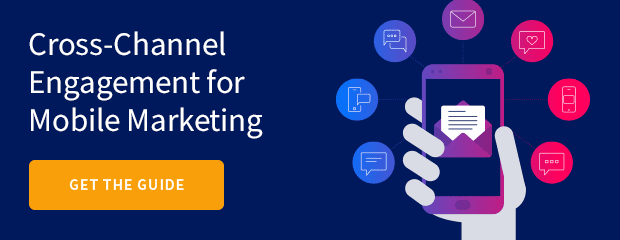There’s no denying that consumers today are incredibly mobile. Nearly 80% of Americans own smartphones, relying on them to browse, engage, and buy like never before.
This all equates to massive growth marketing opportunity. Mobile devices offer a direct yet diversified means of reaching customers through email, SMS, push and in-app notifications.
But not all brands are created equal when it comes to developing mobile marketing that moves the needle—we’ve identified the key strategies that separate the industry leaders from the rest that trail behind.
Make Your Mobile Marketing Count
After working extensively with our customers, helping them build seamless brand experiences, we’ve launched a new guide with our four-step framework for integrating an effective mobile marketing strategy into your cross-channel program.
Whether you’re designing a new mobile app, experimenting with SMS, or looking for more ways to refine your current cross-channel approach, the best practices detailed throughout this guide will help you dramatically increase customer engagement.
We’ve previewed a high-level overview below, and you can download the full guide for an even deeper dive, with use cases and success stories from our customers.
1. Define Your Marketing Goals
You’ll never reach your destination if you don’t know where you’re going. As a precursor to developing any messaging, take a step back and consider what you hope to achieve through your communication.
Naturally, you have certain business goals to hit relating to adoption, engagement, usage, conversions, etc., and these must be translated into customer-friendly campaigns that produce impactful results.
However, your goals won’t always equate to your audience’s goals; you must carefully consider the customer experience and their unique needs, wants, and wishes before you can craft effective messaging.
2. Architect the Customer Lifecycle
With well-defined messaging goals in mind, now it’s time to chart the customer journey. Your customers will move at their own speed as they interact with your website, app and other brand properties, but that doesn’t mean you can’t give them a motivating nudge with a workflow designed for conversion.
Help them progress from point A to B by plotting their journey and identifying all the critical events they’re likely to encounter along the way:
- Creating a user account
- Downloading your app
- Signing up for a free trial
- Purchasing a premium subscription
- …and more
Mapping the customer lifecycle and anticipating lapses in engagement with pre-determined messaging will help keep your brand top-of-mind and drive greater retention.
3. Automate Cross-Channel Messaging
Automation is crucial when integrating your mobile marketing efforts with your programs for email, web and more. If you’re firing off campaigns manually, you run the risk of sending poorly timed or irrelevant messaging.
The wrong message at the wrong time can quickly erode the positive sentiment you’ve invested time and effort into building. Automating these messages ensures real-time accuracy and relevance of your content.
This means you can contact your users with confidence knowing every touchpoint is:
- Unique to their current experience within each lifecycle stage
- Personalized to their recent behaviors and preferences
- Delivered within a contextually meaningful time window
Automation is highly effective for recognizing and acting on customer data for instant user feedback when actively engaging on mobile.
4. Measure and Refine Performance
Like with any other marketing endeavor you take on, iterating on your results and measuring campaign performance is necessary for long-term success.
By following the four-step framework outlined in our guide, you’ve now designed a thorough and clear roadmap for a best-in-class mobile experience.
Just remember—don’t expect perfect results out of the gate. Capturing benchmark data (both the good and the bad) is a must before meaningful refinement can be made. But with a comprehensive understanding of how your experience is built, you’ll be able to optimize with confidence.
Mobilize Your Marketing Today
Delivering mobile experiences worthy of your customers’ time is business-critical.
The right mobile marketing strategy will guide your customers through their entire journey with your brand—all the way from first-touch to check-out and beyond.
To learn how to maximize your mobile relevance, download the full guide: “Optimize Your Mobile Marketing for Cross-Channel Engagement.”































